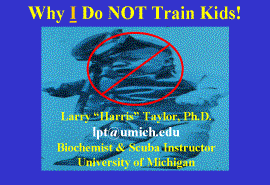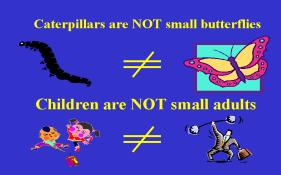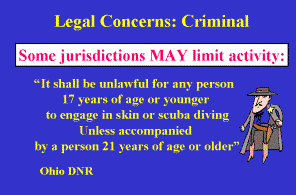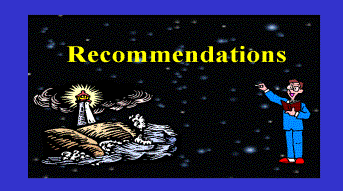

Why I Do NOT Train Kids
by
Larry "Harris" Taylor, Ph.D.
This is an electronic reprint of a talk given in Chicago (Our World
Underwater, April 28, 2001). I have attempted to maintain the "flavor" of the
talk by including minimized copies of the presentation slides. This material is
copyrighted and all rights retained by the author. This article is furnished as
a service to the diving community by the author and may be distributed for any
non-commercial or Not-For-Profit use
Spanish Summary (sans graphics)
The slide set associated with this article is available as a PDF File.
All rights reserved
Go To: Home About "Harris" Articles Slides War Stories Editorials Links Fini
Jump To: Legal Medical Psychological Physiological Meaning
I would like to thank the Our World
Underwater people for their kind invitation to speak on this controversial
topic. Before I begin, I would like to ask you to focus on the title of my talk,
which is why I, as an independent instructor, have chosen not to train
anyone under the age of 18. I have made my decision; each of you must make this
decision based on your own set of values.


Every time we go diving, we participate in a potential life threatening sport. So, all diving activities should employ a risk-benefit analysis. That is, what risks (injury to ego, physical trauma or possibly death) are present for the benefit (recreational fun, Indiana Jones like "Fame and Glory," or financial compensation) I will obtain from this activity? Each of us, because of different genetic and environmental exposure components, will view this risk-benefit equation in a different fashion. Even if all things were equal, because of willingness to accept varying degrees of tolerance to exposure (which will change with each assessment), everyone in the room today will approach this analysis in a different manner. This talk is based on a set of values that works for me. It is NOT my intention to suggest that everyone should share the same values. I only ask from you, the same thing I ask from my students, which is that a risk-benefit assessment be made for all diving activities with the understanding that the benefit is never infinite because the risk is never zero!
Now that that has been said, let us
begin.
A child psychiatrist once said to me, "There is a nation out there of small people and they are NOT like us!" Children do NOT act, think, emote, respond or play as adults.


We do not think of caterpillars as small
butterflies, why should we think of children as merely small adults? Yes, I know
that caterpillars are different from children. Kids are higher up in the food
chain and thus, take far, far longer to develop.


You can tell I have been on the Internet a lot because I am now issuing a soapbox warning. This means the next few slides will be OPINION from a scuba instructor with two decades of teaching experience who just happens to have a very strong "Protect the kid" gene.
To me, the concept of the physically, mentally, and psychologically
mature kid is, at best, an oxymoron and, at the worst, nothing more than
economic predation from an industry whose quality of education has been
strangled by the cancer of greed-driven mediocrity. (Gee, I wonder why I have
never been accused of possessing either tact or diplomacy?)


Recreational scuba training has developed the denial of risk into an art form. Lee Somers, my mentor, once called this profound denial of risk, "The It won't happen to me syndrome." Morgan (1995) in a Sea Grant Study, states that divers are simply NOT being informed of the risks they assume when they scuba dive. The lesson of biology is that once the head has been buried in the sand (risk removed from view), the rear end is exposed and long-term survival must depend upon protection from an outside higher power. Simply put, greed blinds! The lesson of history is that once the perceived need to increase revenue controls thinking, then, often, the best interests of the participants have been forgotten.


Many times over the last two decades I have
been told that in the business of selling c-cards, there is no column in the
ledger sheet for health & safety, quality of education, or in some cases,
adherence to US law. But, the funny thing is that these things do have a way of
entering into the ledger sheet when those who have been sacrificed seek
retribution in the form of increased liability insurance costs, legislation and
litigation. For those who cannot read the lettering on the advertisement on your
upper right, it says something like "Our brand appeals to the younger smoker."
More and more the advertising of our scuba industry (when it denies risk) sounds
like it was written by the same folks who wrote for the tobacco industry of the
1950's. I find the parallels to be both fascinating and disturbing. Over the
long term, denial of risks becomes an extremely expensive way of doing business.
This is the end of the soapbox warning. That
was from the gut, the rest of the talk will be based on what my intellect has
found. (BTW, the perverted among you will recognize the soapbox image below as
one of the most celebrated soapboxes of the 20 th century).


So, what are my concerns about
this topic?
My concerns are the same for all teaching
activities: What are the legal and medical risks incurred by my teaching?
I will start with legal aspects. Remember I
am a biochemist, so I see the world through the eyes of someone trained in the
physical sciences. My experience with the legal community, except for
intellectual property rights, has been minimal. I hope it stays that way!
However, from my simplistic point of view, legal matters can be divided into two
broad categories: civil and criminal. I'll take civil first.


Historically, the denial of risk has NOT been a strong defense, especially when it can be demonstrated to a jury that risks were known and simply dismissed, suppressed, or ignored. I consider the combination of denial of risk, coupled with perpetually diminishing standards to be nothing more than a direct financial contribution from the scuba c-card vendors to the American legal community.


My concern: I believe that the amount of money paid to plaintiffs by the scuba industry has gone beyond absurd into the downright obscene category. But, in MY OPINION, anything paid for adult injuries while diving will be trivial compared to what MIGHT BE PAID for injuries to kids. Juries involved in trials with children plaintiffs tend to see, irrespective of the facts, only an injured or absent child and a greedy defendant. I see the lowering of training age as a liability time bomb. Since the c-card vendors are making a profit, this means that those of us who dive will pay this "cost of doing business."
So, you instructors out there, the next time you bad mouth an attorney, remember the last time you sold a c-card to someone unfit to dive with the person that you love the most.
On the criminal side of things, there may be
areas of the US that have age restrictions on water play. For example, this from
the Ohio DNR over water they supervise. In their waters, it is unlawful for
anyone under the age of 17 to scuba dive without the presence of someone over
the age of 21. This same body of law makes diving solo an illegal act. This
SUGGESTS that in this jurisdiction, an 18-year-old instructor teaching a16
year-old a class in solo diving may not be the best legal position to
defend
Every jurisdiction has so-called "Looney Laws." These are rules and regulations promulgated at some point in time to cover a specific situation. They may remain on the books for decades or more until discovered by an aggressive plaintiff or prosecutor (these things seldom are advantageous to the defendant). Everyone who teaches scuba should have good local legal advice on possible legal restrictions that may exist. I'll leave legal with this warning. If you are ever in the city of Detroit, you should be aware that, regardless of age, all skin diving, scuba diving and wind surfing activities are forbidden in all public fountains within city limits.
I will now move on to medical matters. I have
divided my concerns into two broad categories: psychological and
physiological.


First of all, the statement,
"IT HAS NOT BEEN
PROVED THAT," and here you can insert ANYTHING related to the topic of kids in
diving. is definitely true. There are no documented studies demonstrating that
diving is harmful to children. Nor will there ever be!


The types of studies necessary to confirm/deny the medical concerns about kids, including the unborn, in diving will, most likely, never be done. This is because such research is costly, would involve decades of patient follow-up and is, for the most part, medically un-ethical. So, outside of a concentration camp environment, these studies simply will not happen. You see, while there are areas in society where, historically, women and children are considered prey, medical research has a long, established history of protecting children. Studies on kids must demonstrate a high-perceived benefit for a minimal risk. I know of no bio-ethics or human experimentation committee that would sanction studies to confirm/deny the concerns about multiple hyperbaric exposures in children.
I'll start with concerns about the psychological issues.
I find it fascinating that some who have been stricken with DCS show development of so-called negative personality traits (depression and dysfunctional behavior). For the most part, this has been anecdotal or confined to the commercial or deep diving realm. Although there have been some studies that have established the validity of the so-called "punch drunk" commercial diver, the depths typically involved are beyond the range of most recreational diving. Besides, changes in personality are often subjective and difficult to quantify, particularly in the absence of pre-DCS incident baseline for comparison. To my knowledge, there is only one study (yes, I know that one MUST BE cautious in not over interpreting a single study.) that suggests this type of dysfunction in recreational divers. Sutherland found, in a study specifically aimed at addressing the issue of personality change, that about 60 % of divers they treated in New Zealand for DCS continued to show personality impairment one year after hyperbaric treatment for DCS.


When I talk to neurologists or psychiatrists about this particular study
(and other types of studies on diver's central nervous systems, especially those
which use magnetic resonance imaging emerging on the broad topic categorized as
CNS lesions), I basically hear two things:
1.
Spots on a magnetic resonance image are difficult to quantify to distinct
physiological or psychological characteristics. One needs to exercise extreme
caution in interpreting magnetic resonance images.
2. Changes in personality, regardless of the nature of the injury, SUGGEST a definite change in brain structure.


If I ask these same neurologists or psychiatrists the question, "Is there enough solid data to restrict the training of children for scuba diving?" the answer I get is a consistent, "There is FOR MY KIDS!"
The reason is NOT BECAUSE OF ESTABLISHED MEDICAL HISTORY (which will, hopefully, never exist), but because:
1 The consequences (negative personality development) are considered severe
2.There is no known way of establishing how many dives, to what depth, for what duration, on what breathing mix, for what personality type, at what stage of development are necessary to cause this post DCS personality shift, if such a shift results from hyperbaric exposure. A pharmacologist would say the dose-response curve is unknown.
My Concern: the effects, if any, of diving
on personality development are unknown.
Moving on to something the child
psychiatrists and pediatricians to whom I spoke consider a better-established
reason
for not allowing kids to dive. This is the concept called "Concrete Thinking,"
which is typical of children until the age of 14-17 (as with all concepts
involving people, there are no absolutes, just ranges because of biological
variability)


My first job following graduate school was as a computer coordinator in
the chemical industry. I acted as a liaison between chemical research, computer
services and upper management. This was in the early 70's when scientific
computing was primarily Fortran based mainframes. In my first presentation to
management, I remember telling them that they should think of a computer as if
it were a small child. As long as communication was extremely precise and
limited to simple parameters, the computer would function extremely well. But
the computer did not understand what it was doing. It simply operated by
performing clearly defined instructions. As long as the computer was allowed to
operate under rigid controls, it would function. But, asking the computer to
operate beyond its programming was a prescription for disaster.
Anyone who has used a Windows-based personal computer has experienced what is called "The Blue Screen of Death." This is the result of putting the computer into a state for which the computer has no set of operating instructions. A computer simply freezes and waits to be re-booted. A child cries and waits for mom or dad to solve the problem. Concrete thinkers are simply unable to function outside narrowly defined parameters. They have very little tolerance to conditions beyond their precisely defined instructions.


Concrete thinkers cannot process information or scenarios beyond what they have experienced. They are not able to form a hypothesis and systematically use logic to solve a problem. The ability to do this is called abstract thinking and does not become a useful intellectual tool until mid or late teens. Often a child will recite facts without a clue as to the meaning of the quoted words. (Adults often confuse their child's ability to recite with ability to understand.) For example:
A child can easily memorize Boyle's Law and recite with the dramatic clarity of Robert DeNiro in Men of Honor. This child, exposed to "modern" scuba education (understanding of physics and physiology removed because these things are "unnecessary"), will attempt a Valsalva whenever pain is felt in the ears.
So, the concrete thinker goes underwater (able to recite Boyle's Law at any given moment) and enjoys a great dive in Planet Ocean. However, as the concrete thinker surfaces, pain is felt in the ear. The concrete thinker will associate pain in the ears with "pinch and blow." This concrete thinking diver will continue to make matters worse by repeatedly inflating the middle ear with an attempt to "clear." The concrete thinker is simply unable to process information and seek a solution when defined parameters are exceeded.
On the other hand, someone who understands Boyle's Law and is able to process information will solve the problem in this manner: As I ascend, the gas in the middle ear is expanding. If I feel pain in my ears, it is likely to be because of this increased pressure from the attempting-to-expand gas.. Therefore, "blowing" (increasing middle ear pressure) will only make matters worse. I must reduce the pressure in my middle ear spaces, so I will pinch my nose and GENTLY SUCK..
The concrete thinker makes the problem worse;
the abstract thinker solves the problem!
We participate in a sport where it is impossible to define all the possible scenarios and establish a set of rules for a concrete thinker to function when stressed. For example, I have never heard the Florida tourist people brag about wind chill factors of -20 oF with ice and snow closing their highways. Nor have I heard anyone sing about the icy banks of the Suwannee River. But it happened. I was there and the day was as dark and gloomy as my photo suggests. The good news was that our scuba tanks were filled in an outdoor bath and equilibrated for about an hour. We had to skim the ice from the surface of the water to retrieve our tanks. So, when we went into the water, our SPG's showed a significant pressure increase. It is the only time in my life where the pressure in the tanks increased when I entered the water. I won't tell you how much, because if I did, Bill High would hurt me!
Because the air was so frigid, we opted to change into our wet suits in the motel. On our way to the Little River cave site, we stopped and had breakfast. I gather, from the looks we received, that 5 guys wearing rubber emerging out of the snow was not a typical Florida morning. After a great breakfast, as we left, I heard one of the waitresses say, "Madge, them boys ain't too bright!"
The point of this little story is that Mother Nature Rules our sport and sometimes situations occur which call for non-typical behaviors. These solutions are often site specific! It is NOT possible for us to conceive all possible scenarios and concretely define responses.


Sometimes the difference between tragedy and
an awesome day of diving is the ability to function beyond the concrete because
crisis requires flexibility (something that simply does not exist in the
concrete thinking little kid!)


My Concern: The pediatricians and psychiatrists with whom I spoke consider concrete thinking to be an absolute contraindication to driving a car in public, operating a plane as pilot-in-command, and scuba diving.


There is a growing body of evidence that
suggests that those who begin puberty ahead of their peers appear to be at a
greater risk to injury than those who enter puberty much later. This is because
the development of secondary sex characteristics is not on the same time line as
intellectual development. For the most part, the ability to use abstract
reasoning does NOT APPEAR until age 14-17, irrespective of physical development.
So, although the hormones are raging, the ability to evaluate consequences of
action or possible risk to self or others is simply not present. Concrete
thinkers cannot conceive of their own "finiteness of life" (often called the "immortality
syndrome").
My concern: Those using secondary sex characteristics as a marker for suitability for scuba training would apparently be selecting the population MOST LIKELY to get hurt. So, extreme caution should be employed when you suggest to your friendly neighborhood scuba instructor that the 6 foot, 180 pound, 10 year old with a beard is "mature."


My concern: Carl Edmonds, the
well-respected hyperbaric physician, labeled allowing parents (with no knowledge
of scuba risks or need for abstract reasoning) to determine the suitability for
scuba training a "reprehensible act." I suggest that this term, "a reprehensible
act" will become an oft-repeated plaintiff battle cry when litigation involving
children scuba divers begins.
It is RUMORED that the ability to equalize pressure between the middle ear and ambient pressure is a critical factor in diving. I say RUMORED because last year at the national YMCA scuba convention, Dr. Fred Bove, a noted American hyperbaric physician, recalled an e-mail he had received. Apparently a scuba instructor was concerned because at the end of every class his students had earaches. This instructor wondered if Dr. Bove would explain the correlation between diving and ear pain!


The inability of children to equalize pressure in the middle ears while flying as passengers in commercial aircraft is a significant problem. As a result, there are numerous studies of this inability of children to clear. Basically, the overwhelming majority of kids under age 12 cannot equalize pressure in the middle ear, especially when the pressure in the middle ear is "negative" (middle ear pressure is less than the ambient pressure in the outer ear). Since the pressure changes involved in scuba diving are greater than those seen in commercial aircraft flights (an adult can rupture an ear drum in approximately eight feet of water and I personally know someone who lost their hearing as a result of a surface dive in a pool while a child), it seems reasonable to believe this inability to "clear" would be a problem in diving. Basically, in children, the Eustachian tube is small, flat, and horizontal (compared to an adult's). This orientation makes it difficult for the ear to drain and, as a result, ear infections are more common in kids than adults. This condition, in very small kids, has been termed "glue ears." In addition, the Eustachian tube closes when a child swallows, as compared to opening with an adult. Under so-called "negative pressure," the tube closes and then air movement becomes impossible. This is analogous to trying to do rescue breathing when the tongue has closed the airway. During development (up to about age 20), the Eustachian tube in-folds and forms ridges that prevent the total collapse under "negative" pressure in the middle ear. Thus, while "clearing" may be an easy task for an adult scuba student, it poses a significant problem and major obstacle in training kids because pressure equalization techniques normally utilized in scuba training will not work with a dysfunctional Eustachian tube.
I believe that this inability to clear, coupled with concrete thinking will lead kids to try stronger and stronger Valsalva in order to remove the ear pain.
My concern: The combination of Eustachian
tube anatomy, equalization difficulty, poor instruction and forceful Valsalva
SUGGESTS TO ME that kids are at greater risk (compared to adults)
for middle ear barotraumas.


Now, let's add to this the emerging work on Patent Foramen Ovale (PFO's) and scuba diving. There are too many references on this topic to put in one slide, so see the CNS reference list at the end of this article. We could spend hours on this topic alone. In the interest of time, I will mention only the study by Germonpre that suggests a correlation between forceful Valsalva and cerebral DCS. I would also like to suggest that every instructor, or anyone interested in the PFO question, read the review on PFO's and diving by Krooss (see CNS reference list, below).
Briefly, in the womb, we all had an opening in the heart that allows blood circulation to by-pass the lungs. In the womb, we had no need for the lungs because mom, via the placenta, took care of oxygenation, delivery of foods and removal of cellular waste. At birth, this opening in the heart begins to seal. In about 25-30% of adults (PERHAPS more in kids), this opening has not totally sealed (patent means "open" and foramen ovale refers to an oval shaped aperture that lies in the secondary secondus of the heart, the green arrow, below, roughly illustrates the location). Typically, this does NOT have much clinical relevance in terms of impaired function, but can be a problem in diving because under increased thoracic pressure (common in a Valsalva maneuver), this defect can allow bubbles (which form on every dive) to move into arterial circulation. There is a growing body of evidence that suggests this is of concern to divers. The theory is that the bubbles, once passed into arterial circulation, can lodge in areas of the central nervous system and, over time, lead to deficits in nervous system function.
My concern: The difficulty in equalizing pressure, coupled to PFO correlation to cerebral DCS SUGGESTS TO ME that kids are at a greater risk than adults to CNS damage.


How much greater? I don't know! I do not believe that anyone knows. But whatever the risk, it is too big for me, as an independent scuba diving instructor, to assume! I SUSPECT a jury will ultimately determine the degree of this risk. I also believe that c-card vendor and plaintiff will have vastly different opinions as to the magnitude of this risk.


I consider the possible (NOT certain) CNS impairment to be the most significant concern in the training kids issue. But there are other things to consider. Like the fact that molecular oxygen is a component in one of the chemical reactions that forms connective tissue. It is a general principle of chemistry (Le Chatelier's) that increases in partial pressure of a gaseous component will alter course of a chemical reaction.
My concern: The possible alterations to skeletal
tissue during development as a result of multiple hyperbaric exposures are
unknown.
The airway passages of a child are smaller in comparison to cavity space of the alveoli compared to an adult.
My concern: The narrower airways suggest an increased risk to barotrauma. The magnitude of this increase, if any, is unknown.


Children, because of their smaller net muscle
mass will chill easily.
My concern: The susceptibility to hypothermia (kids will chill long before an adult senses cooling) requires vigilance on the part of the instructor, especially in a class with adults. Hopefully, this can be addressed with shorter immersion periods (with more sessions) for kids and properly fitting thermal protection garments.
There was a study that concluded that
exposure to chlorine before age 15 increases risk of skin cancer. I show this
NOT to suggest that the US should change its method of sanitizing public pools,
but to demonstrate that a few minutes on the Internet will find all sorts of
things that a plaintiff will bring to trial.


Those who dive with oxygen-enriched air will tell you that they "feel better" following dives on this mix as compared to the same dives on compressed air. There has never, to my knowledge, been a scientifically valid study to demonstrate this belief. But many, myself included, believe the observation. The theory behind this observation is that there is "mechanical decompression stress" (movement of inert gas in and out of cellular tissues). The conjecture is that this movement of inert material, unused by the cell, places a mechanical load on the cell and that post-dive fatigue is a symptom of this cellular stress.
My concern: There is, at present, no knowledge of how this process would affect all organ systems during development.
Now, I know that some entrepreneur will conclude from my "decompression fatigue" concern that the logical solution is to train everyone on oxygen-enriched air. Let's look at some basic chemistry.
We live in an atmosphere that contains oxygen, a very reactive chemically promiscuous element. At all times, oxygen is seeking other chemical components with which to react. Consider the reaction:
Oxygen + Anything It can find
===> "Bad Stuff"
(called Reactive Oxygen Species)
Oxygen continually forms "bad stuff," extremely reactive materials like
free radicals, super-oxides, radical anions, etc. that interfere with normal
body metabolism. Because these undesirable constituents are always formed in an
oxygen atmosphere, our body has natural defenses (like super-oxide dismutase,
etc) to cope with these undesirable species as they are formed.
Problems, like CNS oxygen toxicity, occur
when the amount of this "bad stuff" exceeds the body's capacity to deactivate
them. Le Chatelie''s principle tells us that any increase in pO2 will
increase the amount of "bad stuff" formed. So, increases in oxygen partial
pressure will lead to enhanced formation of oxygen radical neurotransmitters
(like NO), as well as other so-called highly reactive species. Some of these
chemical species are among the most powerful DNA mutagens known.
My concern: There is no way of knowing, what effect, if any, diving at recreational depths will have on formation of highly reactive oxygen species and what, if any, effect there will be on development at a time when the body's DNA machinery is in high gear.


I am not a physician, so, in medical matters, I must seek guidance from the medical community and their literature.
SPUMS (Southern Pacific Undersea Medical Society) recommends a minimum age for scuba training as 16.


Dembert and Keith in the late 80's recommended that physicians be overcautious when dealing with potential pediatric scuba divers. They also suggested AT THAT TIME that standards needed to be raised. (I have seen recently certified instructors who could NOT meet the minimum standards for basic scuba under these 80's standards that these physicians felt needed to be raised)


One of the medical articles I read suggested
a reasonable guideline was to wait until the child could drive to the dive site.
Although I will not personally train anyone under age 18 (admittedly on the
conservative side), I typically extend this recommendation (when asked for advice)
to, "parents should wait until they trust their child to drive the family's
most expensive automobile to the dive-training site." I look at adolescence, like
pregnancy, as a temporary, survivable condition that has so many uncertainties
associated with the event that diving is best avoided until this condition is
past.


I would like to close with this thought (see
below) and my profound thanks to Dr. Jim Caruso for permission to quote, my
colleagues at the University of Michigan School of Medicine for their time and
expertise, the Our World folks for their invitation, and you, the audience, for
allowing me to speak uninterrupted.

Finally, Children are
our future. Do not allow someone else's greed to determine their
destiny.

May you all

Acknowledgements:
Clip Art (including anatomical images) from Microsoft Art Gallery module of Office 2000
Hypothermia image courtesy 3M from slide set
on Thinsulate
Backgrounds: Hubble Space telescope images or
anatomical stains from colleagues at U of MI
Enterprise created with software package
Starship Creator 2
Photographs: Those not shot by the author are
believed to be in the public domain
Jump To: Legal Medical Psychological Physiological Meaning
Go To: Home About "Harris" Articles War Stories Editorials Links Fini
About
The Author:
Larry "Harris" Taylor, Ph.D. is a biochemist and Diving Safety Coordinator at the University of Michigan. He has authored more than 200 scuba related articles. His personal dive library (See Alert Diver, Mar/Apr, 1997, p. 54) is considered one of the best recreational sources of information In North America.
All rights reserved
Use of these articles for personal or organizational profit is specifically denied.
These
articles may be used for not-for-profit diving education
The reference lists below were current at the time of presentation.
BIBLIOGRAPHY: CNS IMPAIRMENT
MEDICAL
REFERENCES
A. Bove (1998), Risk of
decompression sickness with patent foramen ovale, Undersea Hyper Med, 25(3),
175-178.
I. Calder, "Changes Found In
The Central Nervous System From Autopsies On Divers," in Lin & Shida (Ed.)
MAN IN THE SEA, Vol. 2, Best Publishing, San Pedro, CA. 1978, 163-180.
J. Francis (1998), Mechanisms
Of Spinal Cord Injury In DCI, SPUMS, 28(1), March, 29-41/
P.
Germonpre, P. Denale, P.
Unger, & C. Balestra, 1998) Patent Foramen Ovale & Decompression
Sickness In Sports Divers, J. Appl. Physiol. 84(5), 1622-1626.
S. Glen, et. al, (1995),
Transcranial Doppler ultrsound in commercial air divers: Aa field study
including cases of right-to-left shunting, Undersea Hyper. Med. 22(2),
129-135.
M. Jensen, M. Brant-Zawadzki,
N. Obuchowski, M. Modic, D. Malkasian, & J. Ross (1994), Magnetic Resonance Imaging Of
The Lumbar Spine In People Without Back Pain, New England J Medicine , 331(2; July 14),
69-73.
M. Knauth, S. Reis, S.
Pohimann, T. Kerby, M. Forsting, M. Duffertshofer, M. Hennerici, & K.
Sartor (1997), Cohort Study Of
Multiple Brain Lesions, In Sport Divers: Role Of A Patent Foramen Ovale, British
Medical Journal, 314 (March 8), 701-705.
P. Langton (1996), Patent Foramen Ovale In
Underwater Medicine, SPUMS, 26(3), 196-191.
R. Moon & J. Kisslo (1998),
PFO and Decompression Illness: An Update, SPUMS, 28(3), 158-163.
A. Newberg & A. Alavi, (1996), The Study Of The Brain Using PET
and SPECT: Implications For Space And Underwarer Neurology, J. Neurological
Sciences, 136, 1-9.
A. Palmer, I. Calder, & J. Hughes (1987), Spinal Cord
Degeneration In Divers, Lancet, December 12, 1365-1366.
A. Palmer, J. Calder, & P.
Yates (1992), Cerebral Vasculopathy In Divers, Neuropathology and Applied
Neurobiology, 18, 113-124.
P. Polkinghorne, K. Sehmi, M.
Cross, D. Minassian, & A, Bird (1988), Ocular Fundus Lesions In Divers,
Lancet, December 12, 1381-1383.
J. Reul, J. Weis, A. Jung, K.
Willimes & A. Thorn (1995), Central Nervous System Lesions And Cervical
Herniations In Amateur Divers, Lancet, 345 (June 3),
1403-1405.
S. Ries, M. Knauth, R. Kern, C.
Klingemann, M. Daffertshofer, K. Sartor, & M. Hennerici (1999), Arterial Gas
Embolism After Decompression: Correlation With Right to Left Shunting,
Neurology, 52, 401-404.
R.
Roos, ((1989), Are The Risks
Of Sport Scuba Diving Being Underestimated? Physician & Sports Med. 17(7),
132-142.
N. Schellart & D. Retis
(1999), Is Magnetoencephalography
Applicable In Clinical Neurophysiology Of Diving? SPUMS, 29(3), 156-158/
S.
Sipinen, J. Ahopuo, & J,
Halonen (1999),
Electroencepalography and Magnetic Resonance Imaging After Diving and
Decompression Incidents: A Controlled Study, Undersea Hperbar. Med. 26(2),
61-65.
A. Sutherland, A. Veale, &
D. Gorman (1993), Neurological Problems In 25 Recreational Divers One Year After
Treatment For Decompression Illness, SPUMS, 23(1, Jan/Mar),
7-11.
K. Todnem, H. Nyland, H.
Skeidsvoll, R. Scihus, P. Rinck, B. Kambestad, T. Riise, & J. Aarli (1991),
Neurological Long Term Consequences Of Deep Diving, British Medical Journal, 48,
258-266.
R. Vaernes & S. Eidsvik
(1982), Central Nervous Dysfunctions After Near-Miss Accidents In Diving,
Aviation, Space & Environmental Medicine, August, 803-807.
P. Warren, W. Djang, R, Moon,
E. Camporesi, D. Sallee, D. Anthony, E. Massey, P. Burger & E. Heinz (1988),
Neuroimaging Of Scuba Diving Injuries To The CNS, AJR, 151 (November),
1003-1007.
P. Wilmshurst, (1997), Brain
Damage In Divers (Letter To Editor), BMJ (March 8), 689-690.
P. Wilmshurst, (1997), Patent
Foramen Ovale & Decompression Illness, SPUMS, 27(2), 82-83. (Letters to Ed
(Langdon & Bove) follow on 83-84)
P. Wilmshurst, C. Davidson, G.
O 'Connell C. Byrne (1994), Role of
cardiorespiratory abnormalities, smoking and dive characteristics in the
manifestations of neurological decompression illness, Clinical Science, 86, 297-303.
BJ. Zink, (2001), Traumatic
brain injury: Concepts for emergency care, Annuals for emergency care, Annuals
of Emergency Care, 37(3), 318-332.
OTHER REFERENCES
-----
(1995) Brain Lesions: New Threat To Divers Or False Alarm? Undercurrent, July,
11.
-----
(1995) DAN Responds To Lancet Article About Long Term Consequences Of Diving,
Undersea Journal, Fourth Quarter, 69.
F. Bove
(1995), Diving Medicine: The New Controversy Over Silent Bubbles, Skin Diver,
October, 28, 145.
Davidson, B.
"Brain Lesions: A
Hidden Heart Defect Raises The Risks," In Depth, 12(5), May, 1997,
14-15.
A.
Bryske (1995), On My Mind: Recent Reports Of Brain Lesions Among Sport Divers
Are The Result Of Poor Science & Bad Reporting, September,
59-60.
D.
Gorman, "Patent Foramen Ovale, Other Circulatory Defects, Silent Brain Injuries
and Scuba Divers," Undersea Journal, Third Quarter, 1997,
14-16.
B.
Krooss, Diving With A Broken Heart, Immersed, Spring, 2001,
32-38.
S.
Shelanski (1997), Brain Damage In Divers?
Scuba Diving, June, 95-96.
S.
Shelanski (1995), Silent Bubbles, Silent Damage? Scuba Diving, January,
95-96.
E.
Smith (1985), Deep Sea Diving May
Cause Loss Of Memory, New Scientist, January 17, 8.
J.Q.
(1995) Crazy About Diving, In Depth, July, 15-16.
Medical
Literature
Bassler, R. Basler, G. Palmer,
A. Garcia, M. Special Skin Symptoms Seen In Swimmers, J. Am. Acad. Dermatology,
43(2), August 2000, 299-395.
Bove, F. Diving In The Elderly & The
Young, in Bove & Davis(Ed) DIVING MEDICINE, W.B. Saunders, Philadelphia, PA.
1990, 164-169.
Brouchard, et. Al. Letter:
Scuba Diving & Diabetes, Am J Dis Child, 141(6) June, 1987,
606-606.
Bylander-Groth, A. &
Stenstrom, C. Eustachian Tube Function and Otitis Media in Children, ENT
Journal, 77(9, ) 1998, 762-769.
Cronau,
H. & Brown, R. Adolescent Medicine, Growth and Development: Physical,
Mental, and Social Aspects, Primary Care: Clinics in Office Practice, 25(1),
March, 1998, 23-47.
Buchta,
R. Letter: Minimum Age Requirements For Scuba Divers, Am J Dis Child, 141(6),
June, 1987, 606.
Dembert, M. & Keith, J.
Evaluating The Pediatric Scuba Diver, AJDC, 140, Nov. 1986, p.
1135-1141.
Edmonds, C. Diving Doctor's
Diary: Scuba Kids, SPUMS, 26(3), Sept. 1996, 154-157.
Fantel,
A. Reactive Oxygen Species In Developmental Toxicity: Review & Hypothesis,
Tetrology, 53(1996), 196-217.
Langton, P. Patent Foramen
Ovale In Underwater Medicine, SPUMS, 26(3), Sept. 996,
186-191.
Mitcheli, L. Glassman, R. &
Klein, M. The Prevention of Sports Injuries In Children, Clinics In Sports
Medicine, 19(4), October, 2000, 821-832.
Orlowski, J. Adolescent
Drownings: Swimming, Boating, Diving, & Scuba Accidents, Pediatr, 17(2),
Feb. 1988, 125-128, 131-132.
Orr, D.
& Ingersoll, G. The Contribution of
Level of Cognitive Complexity and Pubertal Timing to Behavioral Risk in
Young Adolescents, Pediatrics, 95(4), April, 1995, 528-533.
Purcell, G. & Becker, G.
Conservative Management Of Inner Ear Barotrauma Resulting From Scuba Diving,
Otolaryngol Head Neck Surg. 93(3), June, 1985, 393-397.
Steinmetz, W. Safety &
Control Measures In University Scuba Programs, J Am Coll Health Assoc.15(4),
April, 1967, 332-334.
Strangerup, S. Tjernstrom, O.
Harcourt, J. Klokker, M. & Stokholm, J. Barotitis in Children After
Aviation: Prevalence and Treatment With Otovent, J. Laryngol. 110(7), 1996,
625-628.
Strangerup, S. Tjernstrom, O.
Klokker, M. Harcourt, J. &
Stokholm, J. Point Prevalence of
Barotitis in Children and Adults After Flight and Effect of
Autoinflation, Aviation, Space and Envirn. Med. 69(1),1998,
45-49.
Szaz,
M. & Cooper, M. Evaluating The Sport Scuba Diver, Am Fam Physician, 25(5),
May, 1982, 131-134.
Walker.
P. et. al. Effects Of Hyperbaric Pressure On The Growth Plates Of Rats, SPUMS,
27(3), Sept. 1997, p. 125-130.
Williamson, et. Al. Selection
& Training Of Disabled Persons For Scuba Diving: Medical & Psychological
Aspects, Med. J Aust. 141(7), Sep 29, 1984, 414-418.
Wright,
J. & Patterson, M. Resuscitating the Pediatric Patient, Emergency Medicine
Clinics of North America, 14(1), 1996, 220-232.
Sport Diving Literature
-----,
Advanced Open Water program Open To Young Divers, Undersea Journal, 3 rd Quarter,
1994, 45.
-----,
PADI Expands The Dive Market, Undersea Journal, 4 th Quarter, 1996,
11-13.
-----,
17, 000 Boy Scouts Discover Scuba, Undersea Journal, 4 th Quarter, 1995,
7-9.
Byryske, A. C-Cards For Kids,
Dive Training, Nov. 2000, 40-49.
Clymie,
T. How Young Is Too Young, Sources, Fourth Quarter, 1997, 27.
Cumbo,
A. Diving: A Family Affair, Sources, Nov/Dec. 1993, 35-36.
Francis, J. Certifying Loved
Ones, Scuba Diver, May, 2000, 43-47.
Hill,
K. Little Kids Shouldn't Dive, Sources, Nov/Dec. 1991, 69-70.
Kellett, P. Assessment Of The Pediatric Diver,
Undersea Journal, First Quarter, 1992, 26-27.
King,
J. A Family Affair, Dive Training, April, 1998, 55-58.
King,
J, & Cancelmo, J. Family Style, Sport Diving, Mar/Apr. 2000,
58-66.
King,
J. Teaching Your Kids To Snorkel, Scuba Diving, Nov/Dec. 1996,
90-94.
Laboda,
A. Little Buddies: Family Diving, Dive Training, December, 1998, 55-
59.
Laymon,
L. Teaching Teens, Dive Training,
Feb. 1994, 50-53.
Neal,
J. The Diving Gene, Dive Training, April, 1999, 69-73.
Nesbit,
M. Expanding The Youth Market, Undersea Journal, 3 rd Quarter, 1995,
13-15.
Pascal-Guarino, C. Family Dive
Vacation, Skin Diver, May, 1999, 88-92.
Phelps,
All It Takes Is An Open Door, Undersea Journal, 2 nd Quarter, 1998,
58.
Richardson, Age Considerations
For Recreational Divers, Alert Diver, !3th Anniversary Issue,
11.
Rossier, R. Modling Future
Divers, Alert Diver, Mar/Apr. 2000, 27.
Scharf,
The Youngest Diver, Sources, Sep/Oct. 1995, 39-40.
Seldon,
L. Diving Is For Kids, Dive Training, April, 1994, 74-75.
Seldon,
L. It's A Family Affair, Dive Training, Nov. 1997, 74-77.
Shuster, B. You've Heard of
Soccer Moms, But What About Scuba Moms? Dive Training, July, 2000,
78.
Stiefel, V. Junior Divers, Dive
Training, July, 1993, 26-27, 30-33.
Stone,
T. Kids & Diving, Discover Diving, Aug. 1994, 28-29.
Thombs,
P. Junior Divers, Alert Diver, 13 th Anniversary Edition,
8-10.
Twombly, M. Fathers & Sons,
Dive Training, February, 1999, 55-57.
Twombly, M. Like Father, Like
Junior, Dive Training, December, 2000, .69-72.
Walden,
L. The Age Of Scuba, Dive Training, April, 1995, 69-71 (Repeat: Sept. 1997,
83-85)
Walden,
L. Family Values, Dive Training, January, 1995, 18-23.
Walden,
L. The Family Who Dives Together, Dive Training, April, 1996,
36-41.
Walden,
L. Fit + Comfort = Fun, Dive Training, February, 1996, 73-76.
Walden,
L. Kids As Scuba Students, Dive Training, Oct. 1996, 61-63.
Walden,
L. The Transition From Junior To Adult Diver, Dive Training, Dec. 1995,
53-54.
Jump To: Legal Medical Psychological Physiological Meaning
Go To: Home About "Harris" Articles Slides War Stories Editorials Links Fini